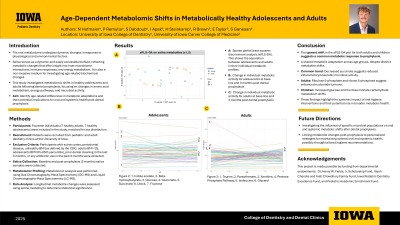Preventive
13 - Age-Dependent Metabolomic Shifts in Metabolically Healthy Adolescents and Adults


Nick Hofmaier, DDS
Pediatric Dental Resident
University of Iowa, Iowa City, IA
University of Iowa
Omaha, Nebraska, United States- SG
Sukirth M. Ganesan, DDS, PhD, MPH
University of Iowa College of Dentistry and Dental Clinics
Iowa City, Iowa, United States - HS
Heidi Steinkamp, DDS PhD MS
University of Iowa College of Dentistry
Iowa City, Iowa, United States
Presenting Author(s)
Research Mentor(s)
Program Director(s)
Purpose: The oral metabolome undergoes dynamic changes in response to physiological and environmental factors. This study investigated shifts in the metabolome of healthy adults and children following dental prophylaxis, aiming to identify age-related differences in metabolic adaptations and their potential implications for oral and systemic health.
Methods: Fourteen participants, comprising 7 healthy adults (BMI < 25) and 7 healthy children (BMI 5th–85th percentile per CDC standards), were included. Active caries and periodontal disease were exclusion criteria. Baseline assessments recorded height, weight, and BMI. Saliva was collected at baseline and after 3 months. Metabolomic profiling was performed using Gas Chromatography/Mass Spectrometry and Liquid Chromatography/Mass Spectrometry. Significance of longitudinal metabolite changes were determined using spline modeling.
Results: In adults, significant reductions were observed in isoleucine, pterin, glycerol, tryptophan, and succinate, while ribulose 5-phosphate and ribose 5-phosphate increased at 3 months. In children, reductions occurred in indoleacetate, beta-hydroxybutyrate, succinate, uracil, o-phosphoserine, and pantothenate, with increases in glycerol, erythrose, fructose, gluconate, and glucose. These changes reflect alterations in amino acid metabolism, energy pathways, and nucleotide synthesis.
Conclusions: Distinct metabolomic shifts in adults and children highlights age-dependent metabolic responses. Decreased succinate in both groups suggests reduced inflammatory or anaerobic microbial activity, while increases in glucose and fructose in children may indicate shifts in carbohydrate metabolism. Ribulose 5-phosphate and ribose 5-phosphate in adults may signify enhanced nucleotide turnover. These findings provide insights into how oral hygiene practices influence metabolic pathways and microbial-host interactions, potentially informing personalized approaches to maintaining oral and systemic health.
Identify Supporting Agency and Grant Number:

.jpg)